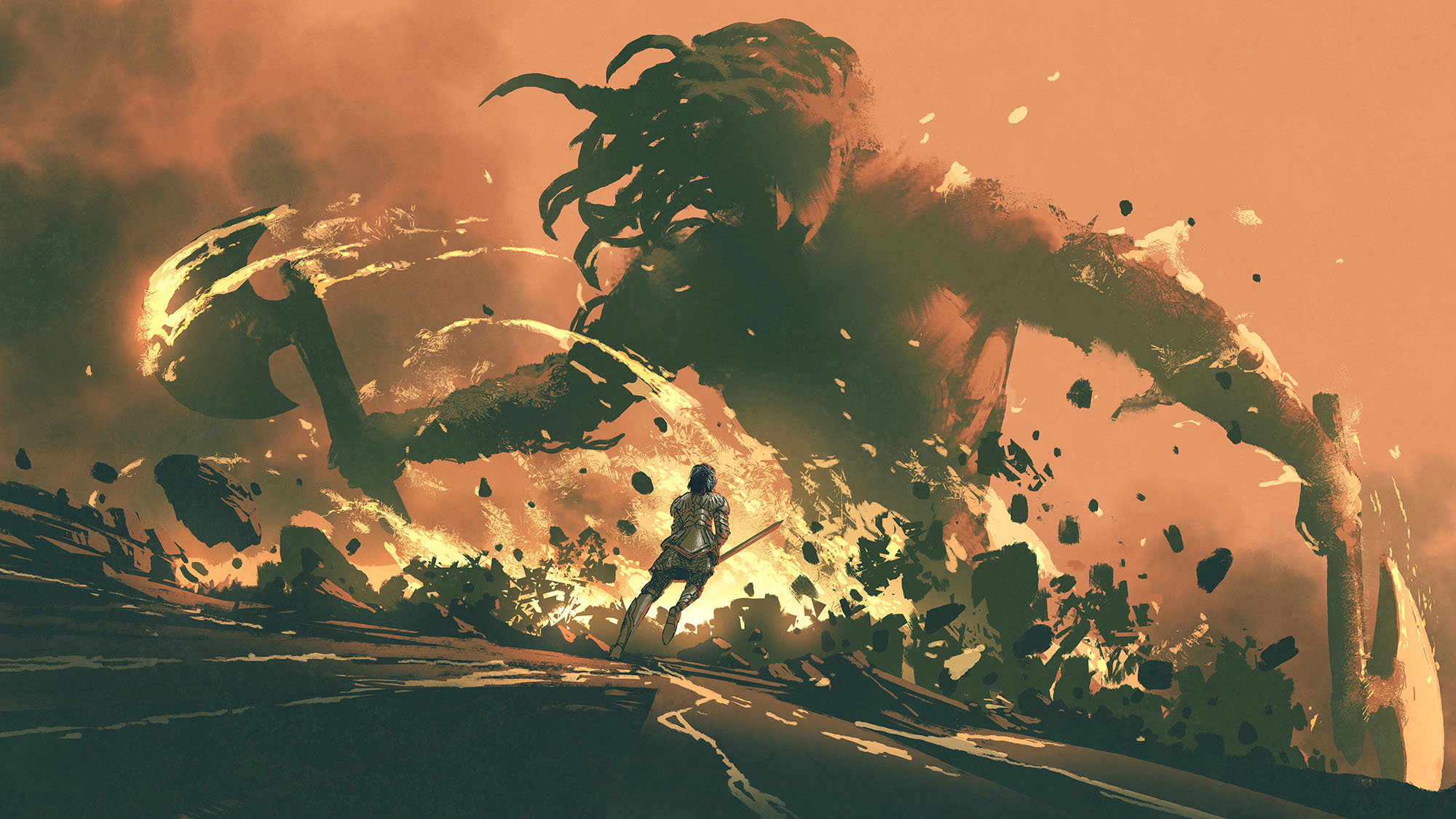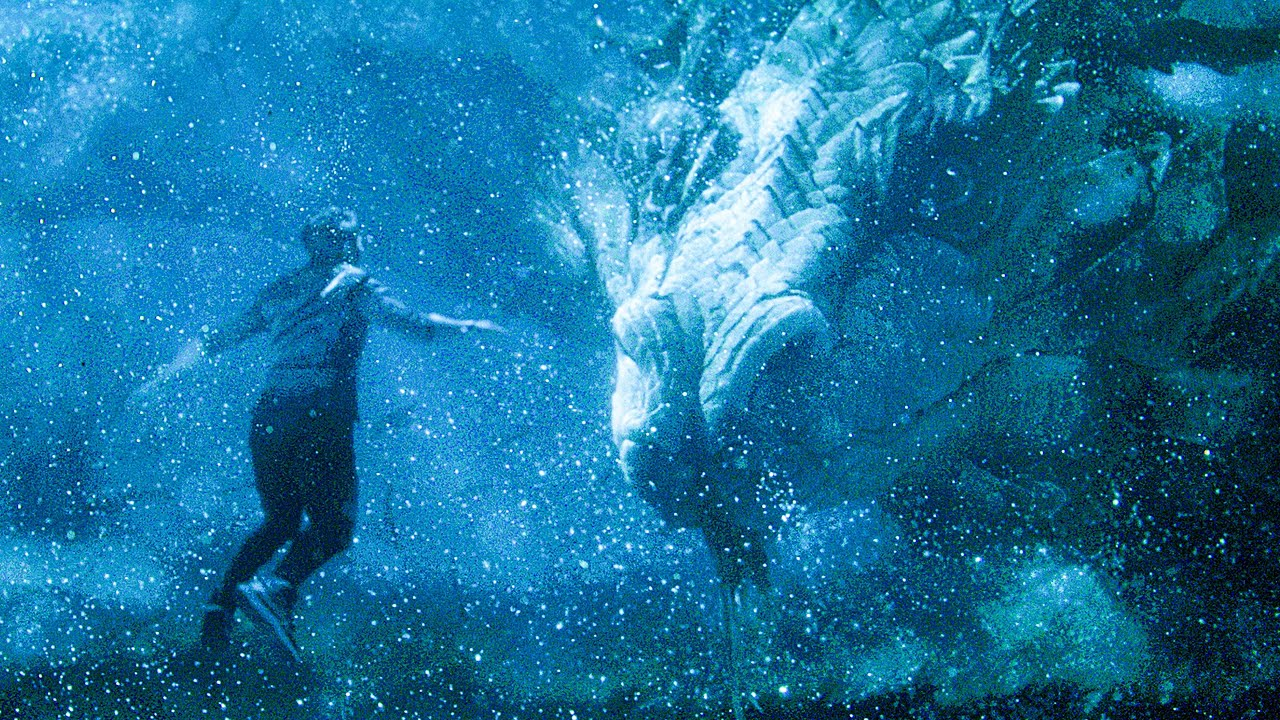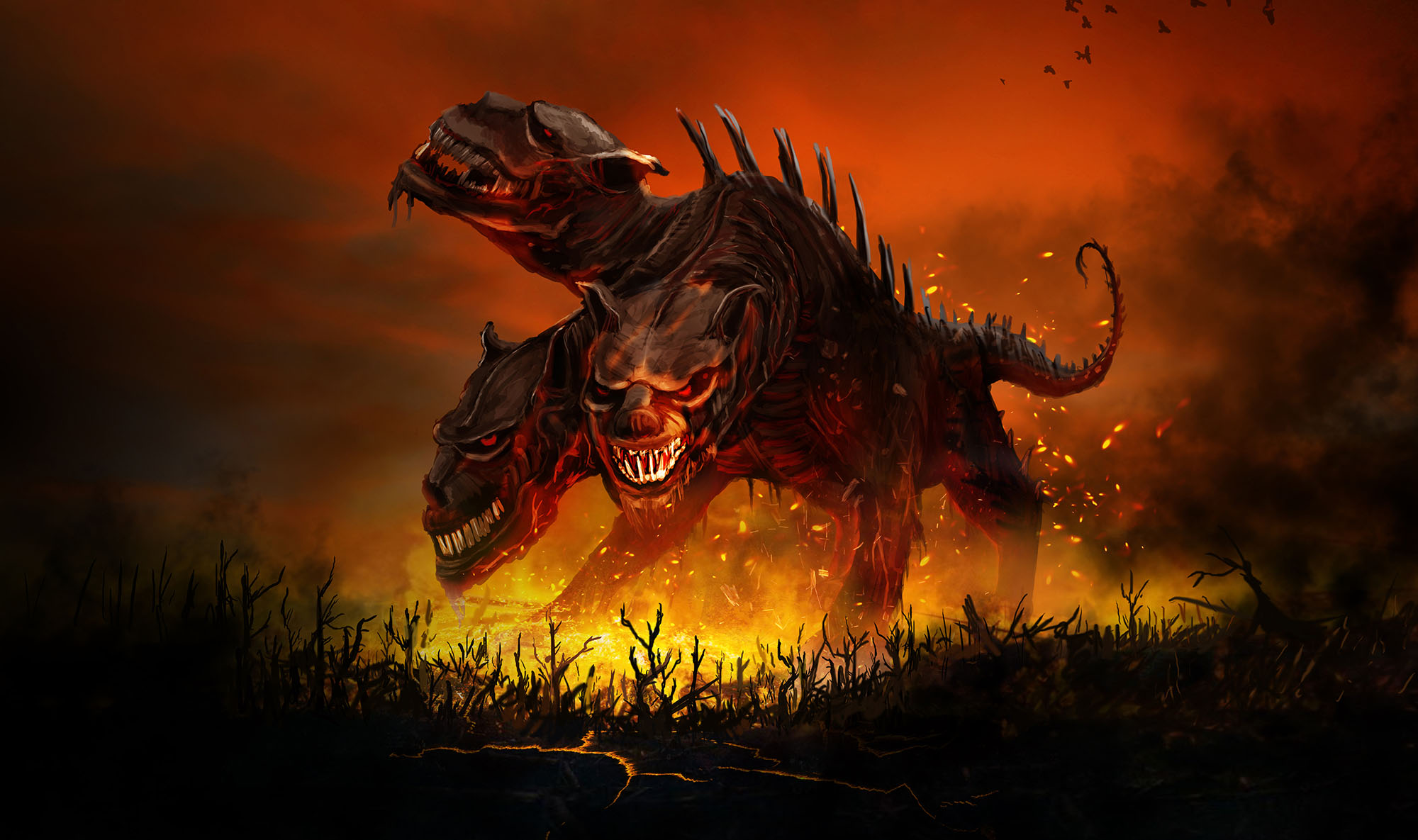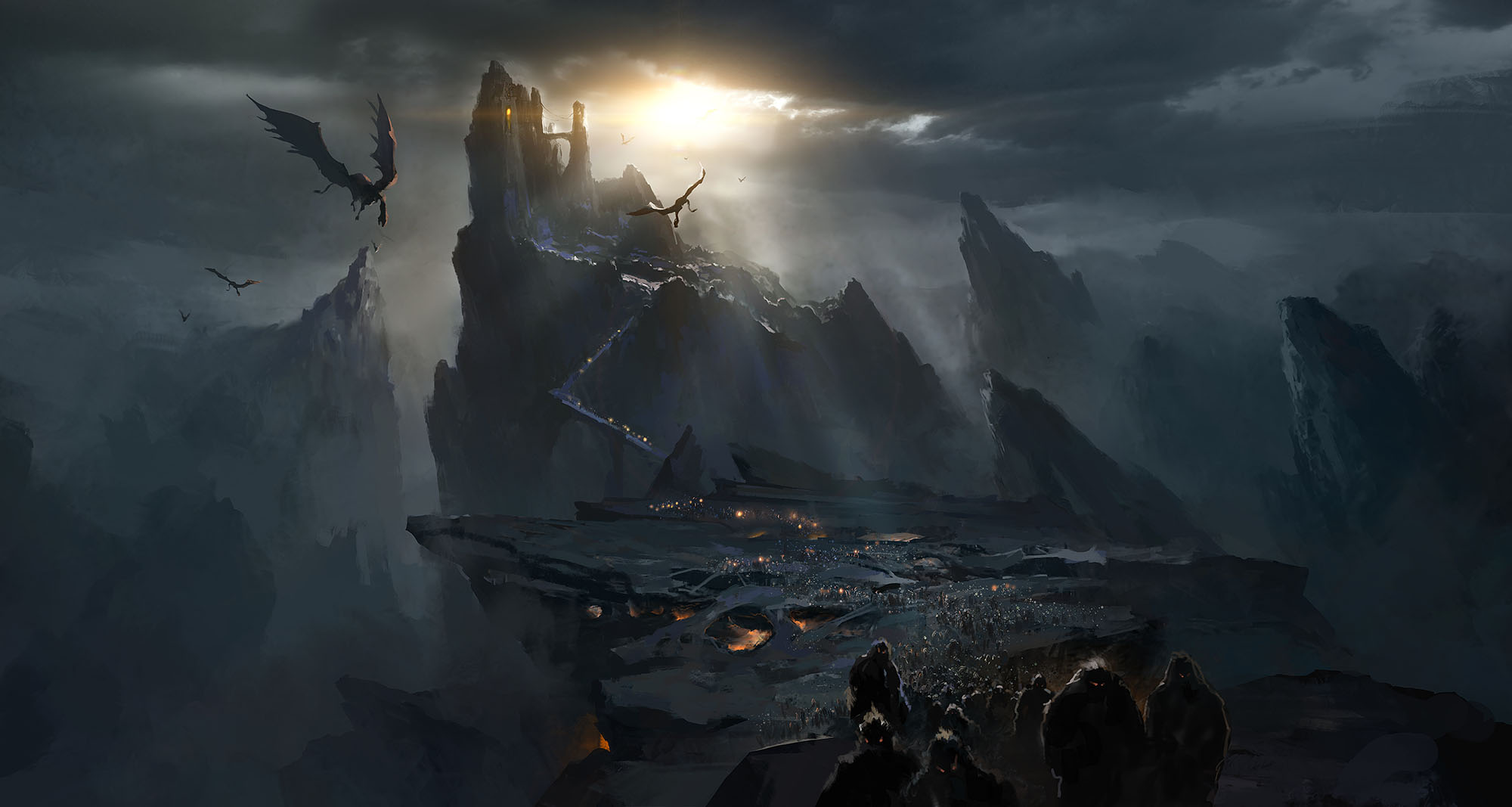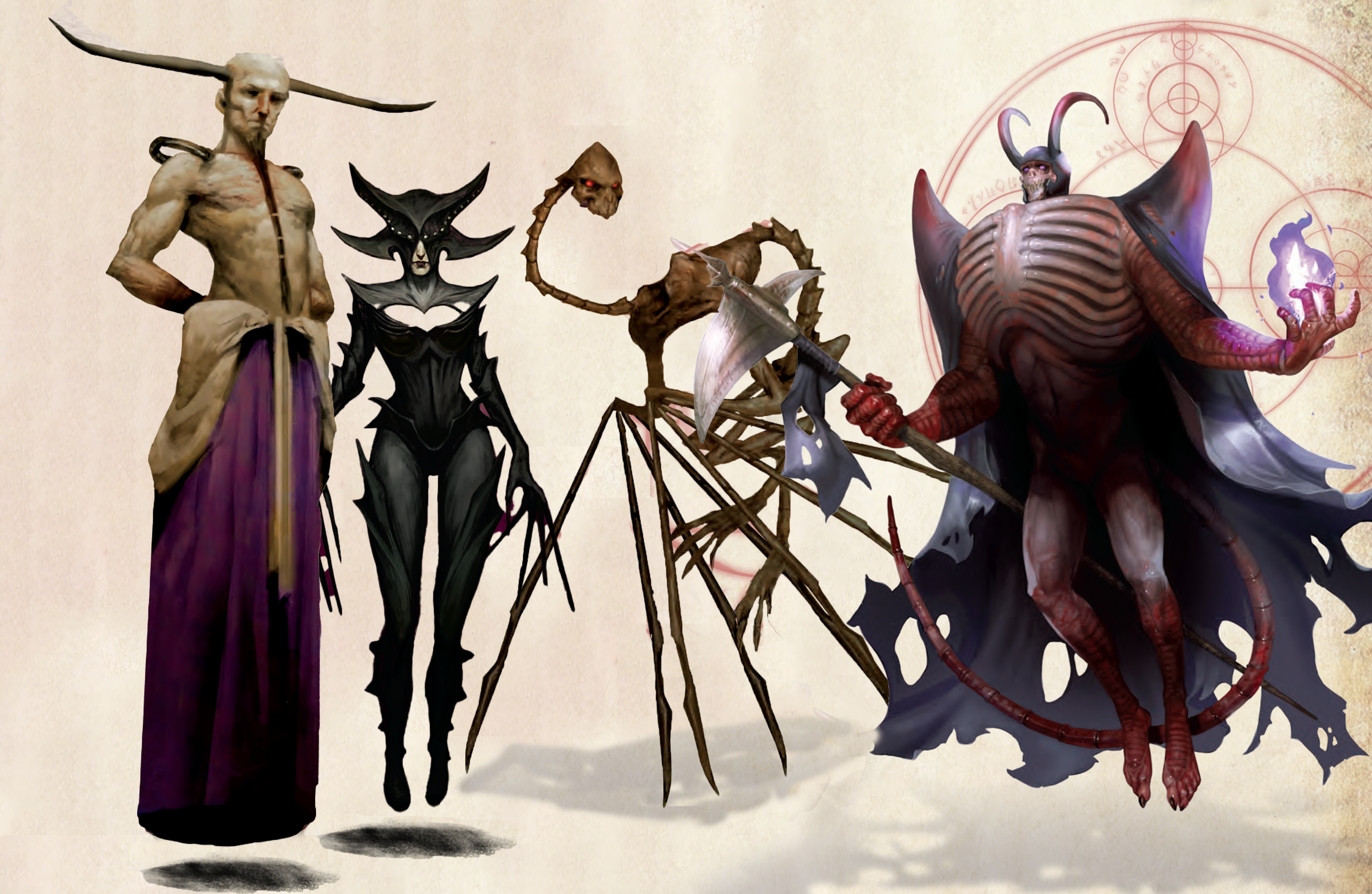Kaiju already exist in D&D. And, using the rules, you can already fight them.
But these mechanics tend to shrink the scope of these creatures. You can square off with a tarrasque, for example, in basically the same way you would with an ogre and poke at it with a spear until it dies. It doesn’t really matter how many squares the tarrasque takes up on the battlemap; it doesn’t feel like you’re fighting something that’s truly enormous. (Particularly if you picture the scene and realize you’re really just tickling its toenails.)
So what should a fight like this look like?
For our touchstones, let’s consider the Bahamut fight form Final Fantasy VII: Advent Children:
The dragon fight from God of War 4:
And the Dweller in Darkness fight in Shang-Chi: Legend of the Ten Rings:
(Video Coming Soon!)
Which is particularly notable, I think, because it features kaiju on both sides of the fight, with human combatants wedged between them.
In each of these fights, there are also common elements that jump out for me:
- Ranged attacks obviously feature quite a bit. (Although they can usually be described as bouncing almost harmlessly off the creature’s thick hide, unless a particular weak spot can be hit.)
- In order to be effective, characters have to literally be on the kaiju.
- The fights feature lots of terrain being casually devastated… including, frequently, the places where the PCs are standing or were just standing a moment before.
Finally, for something a little different, let’s add literally this entire game:
Shadow of the Colossus has a very different pace from the other examples, which I think is useful for keeping in mind when considering the breadth of what kaiju encounters can be.
HEY! I DON’T WANT THAT!
Some of you reading this are undoubtedly thinking, “I don’t want humans running along dragon spines! It’s silly! I want grounded, gritty fantasy! It’s not realistic to think that a normal human could solo Smaug with a sword!”
Short version: These rules are not for you.
Long version: Neither is D&D. By which I mean that the unmodified rules for D&D already let high-level characters solo Smaug. So if that’s not the sort of thing you want your D&D characters to be doing, you’re already having dissonance with the system. Check out E(X): The Many Games Inside the World’s Most Popular Roleplaying Game for an approach that will let you dial in the experience you want.
DEFINING YOUR KAIJU
There are a lot of big monsters in D&D. What counts as a kaiju?
Some key things that I, personally, would think about are:
- Is this monster big enough that it’s basically part of the scenery? A very active part of the scenery, yes, but basically the size of a building or even bigger.
- Is this monster so large that it’s difficult to imagine someone standing on the ground next to them even being able to reach their vital organs?
- Is this monster capable of trivially destroying human-scaled objects while barely even noticing that they’re doing it?
I think the lowest cut-off that makes sense to me (again, speaking only for myself personally) would be at least the size of a storm giant. (Storm giants stand 26 feet tall, are probably 6-7 feet across at the shoulders, and their knees would be about 8 feet above the ground.) And I’d probably want to aim a little bit higher than that.
So as you’re looking at the kaiju rules below, think about what scale of creature they feel right for. Here are a few options to consider.
OPTION #1: GARGANTUAN CREATURES
The simplest metric would be to just declare all Gargantuan creatures to fall under the kaiju rules. This conveniently includes all our likely suspects: tarrasques, rocs, dragon turtles, ancient dragons, and purple worms.
Using this option, the rules for fighting kaiju would only apply to Large or smaller characters. (Huge or Gargantuan characters are close enough to the kaiju in size that no special rules need apply.)
OPTION #2: THREE SIZES LARGER
Alternatively, we could extend this logic to say that any creature three size categories larger than you is considered a kaiju. This would mean that Small creatures would have to treat Huge creatures as kaiju.
This makes a certain amount of sense. If we use our previous example of a 26-foot-tall storm giant, its size relative to a halfling would be like a 50-foot giant relative to a human. (This would actually be the same height as a tarrasque!)
The drawback, of course, is a practical one: PCs can be both Small and Medium size. When encountering Huge creatures, some of the PCs would consider them kaiju and others wouldn’t. You might consider this a feature (and even a great roleplaying opportunity), but it would undoubtedly add the possibility for confusion and probably some potential issues with balance.
OPTION #3: TWO SIZES LARGER
This is the option that treats storm giants and treants as kaiju-class foes for human opponents. However, it would also mean that Large creatures would be treated as kaiju for Small PCs, and Large opponents are actually quite common in D&D. So this would almost certainly result in the kaiju rules being used frequently.
OPTION #4: BESPOKE KAIJU
It’s a kaiju if I say it is.
You might choose this option if you want to include specific corner cases (like storm giants, who are near the high end of the Huge class). This can also be appealing if you just want to include the occasional kaiju-themed encounter in your campaign, but then not worry about the kaiju rules every single time some big monster shows up for a tussle.
THE KAIJU RULES
In order to engage a kaiju, you enter its space while moving or as a reaction to being the target of a kaiju’s melee attack. This usually requires some form of check (e.g., a Strength (Athletics) to jump onto the kaiju from above or a Dexterity (Acrobatics) to grab on as it flies past). This check is contested by the kaiju’s Dexterity (Acrobatics) check to avoid the little pests.
Being engaged with a kaiju usually means that you are physically on the kaiju in some way. Being engaged is an exception to the normal movement rules preventing you from willingly ending your move in another creature’s space. As long as you are engaged with the kaiju, you will be carried with the kaiju when it moves.
Characters who are not engaged with the kaiju suffer disadvantage on their melee attacks targeting the kaiju. Characters engaged with a kaiju gain advantage on their melee attacks targeting the kaiju.
Shake Loose: As a special melee attack, a kaiju can attempt to shake off anyone currently engaged with it. When they do so, all engaged characters must succeed on a Strength (Athletics) or Dexterity (Acrobatics) check contested by the kaiju’s Strength (Athletics) check. On a failure, the engaged character is shaken loose into an adjacent space of their choice and is no longer engaged with the kaiju. They must also succeed on a DC 15 Dexterity saving throw or suffer 2d6 falling damage (or more if the creature was flying at a height greater than 20 feet).
Siege Monster: All kaiju are given the Siege Monster ability. They deal double damage to objects and structures.
Kaiju Destruction: All kaiju are given the Kaiju Destruction ability. They can deal damage to structures within reach as a bonus action.
Design Notes: These rules are deliberately quite simple. Our goal is not to weigh the system down with a lot of detailed mechanics, but rather to provide a straightforward prompt for DMs and players to dynamically describe these battles.
ADVANCED KAIJU RULES
Flying Characters: Flying characters and characters on flying mounts do not suffer disadvantage when making melee attacks against a kaiju.
Engage with Vantage: If circumstances allow a character to attack a kaiju’s vulnerable areas, then, at the DM’s discretion, it will not be necessary to engage with the kaiju in order to avoid suffering disadvantage on melee attacks against it.
For example, a character might be located on a wall or in a tower that the kaiju is passing by. Or they might be riding another kaiju.
Such vantage points do not grant advantage on attacking the kaiju, but may grant advantage on skill checks to engage the kaiju.
Hey! I Was Standing On That! When a kaiju destroys a structure that a PC is standing on, they can attempt a DC 15 Dexterity check as a reaction to land on the kaiju and immediately engage it.
Helping Others to Engage: This can be done with a standard Help action, granting advantage to the aided character’s skill check to engage the kaiju.
Knocked Off: If a character is knocked off a kaiju, the DM may allow them a DC 12 Dexterity saving throw to grab hold of a lower point on the kaiju and remain engaged. In addition to deliberate enemy action (kaiju gnats or other allies fighting the PCs on the kaiju’s back), the DM might also call for such saving throws (possibly at a higher DC) in response to environmental conditions — when the kaiju smashes through a wall or flies through a waterfall, for example.
ROLEPLAYING KAIJU
Nothing in the rules of 5th Edition requires motion, but these creatures are simply massive and even a single step that might only be a small adjustment for a human-scale character can easily chew up significant distance.
So you’re under no compulsion, but describe your tarrasques not only staggering back from mighty blows, but actually moving across the battlefield as they do so (and even chewing up their bonus action to unintentionally smash through a wall along the way). Have your ancient dragons constantly swooping back and forth across the battlefield.
Also keep in mind that these gargantuan creatures may not immediately pay any attention to the PCs, or simply disregard them as irrelevant. (In much the same way that we might see a chipmunk or sparrow in the woods and just… not care that much.)
This, in turn, sets up the moment when the kaiju is suddenly VERY MUCH PAYING ATTENTION TO YOU. That’s a big moment. Play into it.
It’s not unusual for the property damage inflicted by a kaiju to unwittingly prove its undoing: Leave large, heavy, sharp objects dangling precariously and then let the kaiju linger under them for a round or two.
REVERSE KAIJU ADVENTURE
The limited range of size categories in 5th Edition (compared to previous editions) prevents this idea from being directly supported by the rules, but it might be fun to frame an adventure or encounter in which the PCs are the kaiju.
Their opponents might be diminutive Lilliputians or perhaps a scurrying mass of anthropomorphized mice. Either way, the kaiju mechanics work the same in both directions, and you can describe the little folk clutching the PCs’ hair or scurrying inside their armor.
Another option along these lines is to give the PCs temporary (or permanent) control over a gargantuan construct, which can benefit from its status as a kaiju-class combatant.

